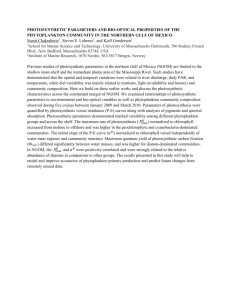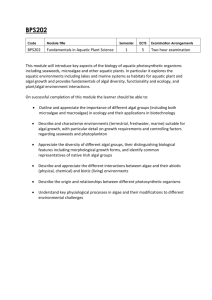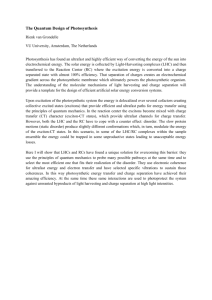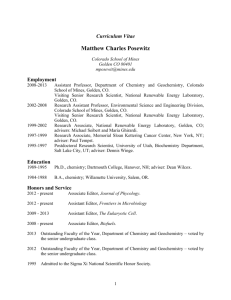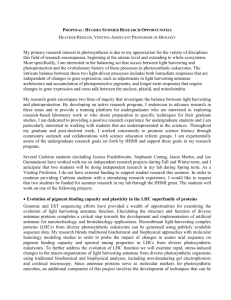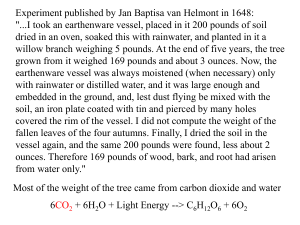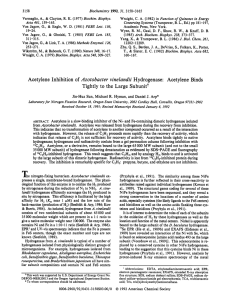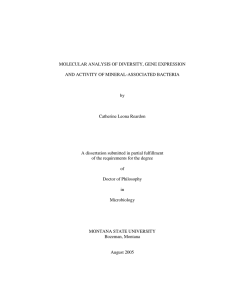Approaches to Developing Biological H2 Photoproducing
advertisement
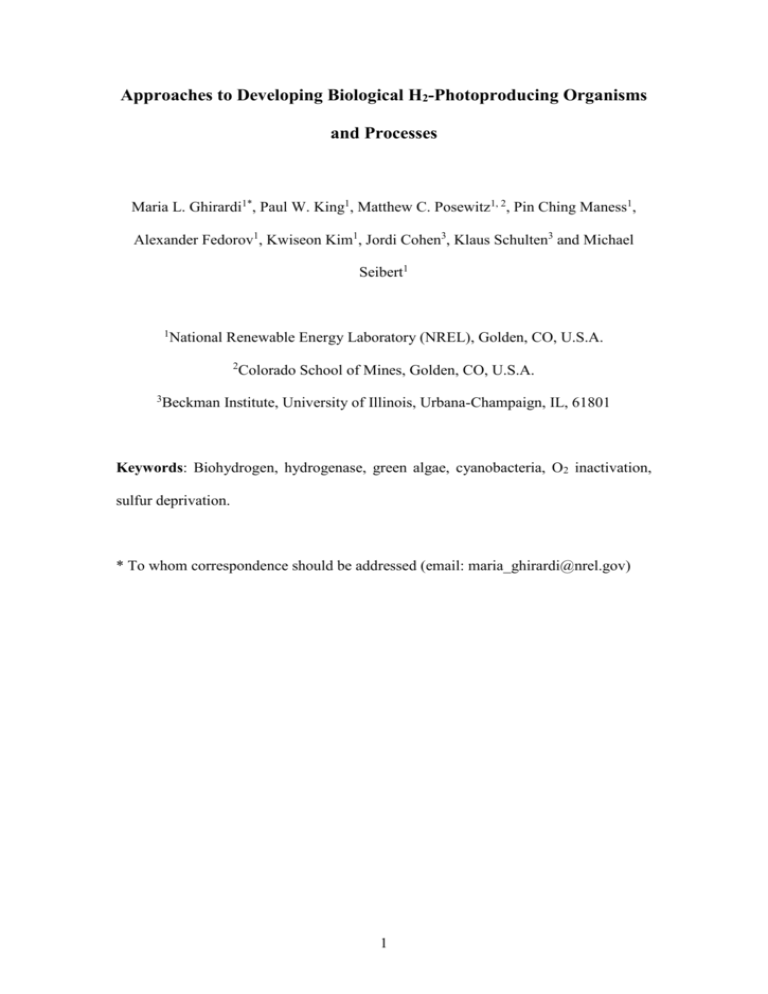
Approaches to Developing Biological H2-Photoproducing Organisms and Processes Maria L. Ghirardi1*, Paul W. King1, Matthew C. Posewitz1, 2, Pin Ching Maness1, Alexander Fedorov1, Kwiseon Kim1, Jordi Cohen3, Klaus Schulten3 and Michael Seibert1 1 National Renewable Energy Laboratory (NREL), Golden, CO, U.S.A. 2 3 Colorado School of Mines, Golden, CO, U.S.A. Beckman Institute, University of Illinois, Urbana-Champaign, IL, 61801 Keywords: Biohydrogen, hydrogenase, green algae, cyanobacteria, O2 inactivation, sulfur deprivation. * To whom correspondence should be addressed (email: maria_ghirardi@nrel.gov) 1 Introduction Biological H2 production linked to photosynthetic water oxidation is a promising technology that may play a major role in the future of renewable energy [1,2]. Photosynthetic microorganisms, such as green algae and cyanobacteria, have the potential to efficiently store the energy of incident sunlight as high-energy H2 molecules, with a maximum theoretical efficiency of about 13%. To achieve sustained H2 production, however, photosynthetic organisms need to be able to produce H2 gas directly from water at maximum photosynthetic efficiency. This presents a major challenge, due to the high sensitivity of hydrogenases to O2 inactivation [3]. Three approaches are being pursued at the National Renewable Energy Laboratory (NREL) to address this issue. In this overview, we describe these approaches and discuss recent advances in each. 1. Engineering an O2-Tolerant Fe-hydrogenase In the green alga Chlamydomonas reinhardtii, H2 photoproduction is catalyzed by one or two Fe-hydrogenases [4,5]. Both enzymes are transcriptionally and posttranslationally regulated by O2 concentration and by other still unidentified metabolic factors [3,6]. These observations agree with the fact that Fe-hydrogenases are more sensitive to O2 than their NiFe counterparts [7]. In the literature, one finds two main determinants of hydrogenase O2 sensitivity: the structure of the catalytic site [8] and the accessibility of the catalytic site to O2 gas [9]. In our work, we have focused on the latter determinant, and initiated detailed studies of gas diffusion through Fehydrogenases in order to identify the most probably pathways for O2 and H2 gases. Our molecular dynamics simulations are based on the crystal structure of the highly homologous Clostridium pasteurianum CpI Fe-hydrogenase, due to the lack of a 2 solved structure for the algal enzymes. Preliminary experiments have identified a few potential individual pathways for O2 gas diffusion, but multiple pathways for H2 diffusion [see Cohen et al., this publication]. These results are in contrast with the observation that there is a single H2 channel that links the catalytic site to the surface of the enzyme, as proposed for the Desulfovibrio desulfuricans Fe-hydrogenase based on probing of its X-ray structure with a 0.75Å probe [9]. The difference between the two observations may be due to the dynamic nature of our simulations, as opposed to the static assumptions of [9]. Nevertheless, our results underscore the possibility of selectively affecting O2 diffusion into the enzyme without disrupting H2 gas diffusion from the catalytic site. Further in silico and in vitro experiments are being developed to test this hypothesis, taking advantage of a recently developed system for expression of Fe-hydrogenases in E. coli. 2. Construction of a Recombinant Cyanobacterium Expressing an O 2-Tolerant NiFe-Hydrogenase In contrast with green algae, cyanobacteria are photosynthetic microbes that contain NiFe-hydrogenases. Until recently, it was not clear whether photosynthetic reductants could be directly utilized for hydrogenase-catalyzed H2 production in these microbes [10]. However, Cournac et al [11] recently demonstrated that a Synechocystis strain, deficient in the type I NADPH-dehydrogenase complex was able to produce significant amount of H2 in the light. This observation opens up the door to exploring cyanobacteria as an additional potential system for H2 photoproduction from water. Research conducted at NREL has uncovered an O2-tolerant NiFe hydrogenase from the purple non-sulfur photosynthetic bacterium, Rubrivivax gelatinosus CBS. 3 The in vivo half-life of this hydrogenase is 21 hours in air, and 6 hours in air when the protein is partially purified [12]. Genes encoding the CBS hydrogenase and its accessory proteins were sequenced recently. Work has been initiated to transfer and express the O2-tolerant hydrogenase genes from CBS into Synechocystis so that the resultant recombinant organism can evolve H2 continuously during normal oxygenic photosynthesis. 3. Green Algal H2 Production Following Partial Inactivation of Photosynthetic O2-Evolution Activity A third approach to sustain algal H2 photoproduction consists of depriving an algal culture of sulfate, required to provide proteins with sulfurylated amino acid residues. The protein most affected by sulfur deprivation in green algae is D1, the components of the water-oxidizing Photosystem II that displays the fastest rate of turnover. As the cultures move from sulfur-replete to sulfur-deprived medium, D1 turnover decreases, causing an overall reduction in photosynthesis [13]. Indeed, we have demonstrated that, within 24 h, the photosynthetic capacity of the cultures decreases below that of respiratory O2 consumption. As shown in Figure 1, as a result, the culture becomes anaerobic, CO2 fixation is interrupted, and accumulated starch is degraded. Depending on the rate of starch degradation, the cultures can either (a) oxidize all starch to CO2, thereby consuming the residual photosyntheticallyevolved O2, or (b) resort to partial anaerobic metabolism as well, excreting formate and acetate into the medium [14]. The H2-production phase is temporary, due to the eventual effect of sulfur deprivation on all other cellular functions. We have demonstrated that the cultures can cycle between a sulfur-replete, photosynthetic O2 evolution mode and the sulfur- 4 depleted, H2-photoproduction mode for at least three times without significant loss of activity [15]. However, preliminary economic analyses at NREL attributed significant costs to the cycling of cultures, which led us to develop a continuous, chemostat-based system for algal H2-production [Fedorov et al., submitted]. This latter development resulted in a decrease in the cost of H2 production by a factor of three. Finally, current developments include attempts to immobilize sulfur-deprived cells onto glass fibers at high cell density, which has resulted in increased stability and increased volumetric rates of H2 production. Conclusion Although still under investigation, biological H2 photoproduction represents a potentially revolutionary technology to harvest solar energy and store it in an easily transportable chemical form. The O2 sensitivity of the hydrogenase enzyme is, however, only one of many obstacles to the development of a truly commercial system. Major developments in algal physiology and genetics, electron transport, light-harvesting optimization and photobioreactor engineering will also bee required to achieve efficient coupling of photosynthetically-generated reductants to H2 gas , production. Acknowledgments: This work was funded by the U.S. Department of Energy, Office of Energy Efficiency and Renewable Energy, Hydrogen, Fuel Cells and Infrastructure Technologies Program, and the Office of Sciences, Basic Energy Sciences, Division of Energy Biosciences, under Contract No. DE-AC36-99GO10337 to NREL. 5 References: 1 Melis, A. (2002) Int. J. Hydrogen Energy 27, 1271-1228. 2 Levin, D.B., Pitt, L. and Love, M. (2004) Int. J. Hydrogen Energy 29, 173185. 3 Ghirardi, M.L., Togasaki, R.K. and Seibert, M. (1997) Appl. Biochem. Biotechnol. 63-65, 141-151. 4 Happe, T. and Kaminski, A. (2002) Eur. J. Biochem. 269, 1022-1034. 5 Forestier, M., King, P., Zhang, L., Posewitz, M., Schwarzer, S., Happe, T., Ghirardi, M.L. and Seibert, M. (2003) Eur. J. Biochem. 270, 2750-2758. 6 Posewitz, M.C., Smolinski, S.L., Kanakagiri, S., Melis, A., Seibert, M. and Ghirardi, M.L. (2004) Plant Cell 16, 2151-2163. 7 Frey, M. (2002) Chem. Bio. Chem. 3, 153-160. 8 Bleijlevens, B., Buhrke, T., van der Linden, E., Friedrich B. and Albracht S.P.J. (2004) J. Biol. Chem. 9 Nicolet, Y., Piras, C., Legrand, P., Hatchikian, C.D., Fontecilla-Camps, J.C. (1998) Structure 7, 12-23. 10 Tamagnini, P., Axelsson, R., Lindberg, P., Oxelfelt, F., Wűnschiers, R. and Lindblad, P. (2002). Microbiol. Mol. Biol. Rev. 66, 1-20. 11 Cournac, L., Guedeney, G., Peltier, G. and Vignais, P.M. (2004). J. Bacteriol. 186, 1737-1746. 12 Maness, P. C., Smolinski, S., Dillon, A.C., Heben, M.J. and Weaver, P.J. (2002). Appl. Environ. Microbiol. 68, 2633-2636. 13 Melis, A., Zhang, L., Forestier, M., Ghirardi, M.L. and Seibert, M. (2000). Plant Physiol. 122, 127-135. 14 Kosourov, S., Seibert, M. and Ghirardi, M.L. (2003) Plant Cell Physiol. 44, 146-155. 15 Ghirardi, M.L., Zhang, L., Lee, J.W., Flynn, T., Seibert, M., Greenbaum, E. and Melis, A. (2000). Trends Biotech. 18, 506-511. 6 Figure Legends Figure 1. Physiological effects of sulfur deprivation 7


